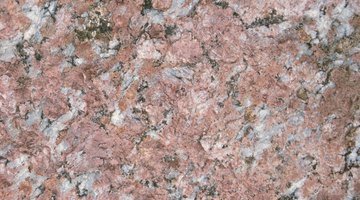How to Remove Lime From Quartz Countertops
Quartz countertops’ luxurious hues and brilliant luster give kitchens a refined appearance. Although practically stain resistant, quartz countertops may encounter water-related blemishes, such as limescale. Minerals in tap water transfer from cookware, dishes and drinking glasses onto quartz countertops.

Furthermore, cleaning and rinsing quartz countertops with hard water also produces limescale, especially when homeowners neglect to dry them. Limescale typically appears as pale white film, and becomes more bonded to quartz countertop surfaces over time. Promptly remove limescale from quartz countertops using certain supplies.
Things You Will Need
- Non-acidic limescale remover
- 2 cloths
- Distilled water
- Dry, 0000-grade steel wool
- Towel
Warning
Acidic limescale remover etches quartz countertops.
Coarse steel wool may scratch quartz.
-
Douse the limescale-stained portion of the quartz countertop liberally with non-acidic limescale remover. Follow the limescale product’s label.
-
Moisten a cloth with distilled water. Wipe the non-acidic product and dissolved limescale off the countertop.
-
Examine the countertop for stubborn limescale. If crusty white residue persists, saturate it in more non-acidic limescale remover.
-
Scrub the saturated limescale with dry, 0000-grade steel wool. Rub the steel wool over the quartz using back-and-forth motions until the limescale loosens.
-
Moisten another cloth with distilled water. Wipe the non-acidic product and remaining limescale deposits off the quartz countertop.
-
Wipe the countertop with a towel. Remove all moisture from the quartz.
The Drip Cap
- Quartz countertops’ luxurious hues and brilliant luster give kitchens a refined appearance.
- Furthermore, cleaning and rinsing quartz countertops with hard water also produces limescale, especially when homeowners neglect to dry them.
- Wipe the non-acidic product and dissolved limescale off the countertop.
- Moisten another cloth with distilled water.
References
Writer Bio
April Dowling first started writing in high school and has written many news articles for newspaper and yearbook publications. She is currently pursuing a career as an online writer and affiliate marketer. Dowling writes for several websites and keeps many blogs.
Photo Credits
- Hemera Technologies/AbleStock.com/Getty Images
- Hemera Technologies/AbleStock.com/Getty Images
More Articles
- How to Clean Kool-Aid Stains on Kitchen Countertops
- What Is the Difference Between Quartz & Silestone Countertops?
- How to Remove Limescale From Natural Stone Tiles
- How to Remove Hard Water Haze, Spotting, and Soap Haze From Glass and Glassware
- How to Clean White Spots in Slate Tile
- How to Remove Tile Adhesive From Plaster



